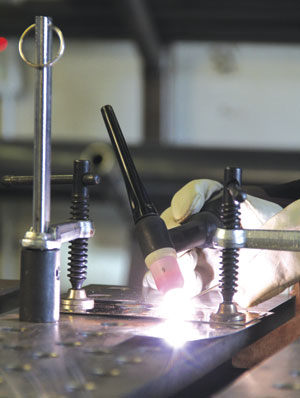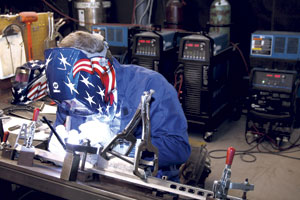by Nestor Gula
Getting a grip on pulsed TIG welding
Of the three main welding processes, Gas Tungsten Arc Welding, GTAW or TIG is the most precise and elegant. A skilled welder can create great looking, clean and solid welds in a variety of materials.
Developed in the 1930s, GTAW came to prominence during WWII as a method to weld aluminum aircraft parts and other more exotic materials for the war effort. Pulsed TIG welding, a feature on some of the most advanced machines, is an enhancement that offers even more control and more weld precision.
“With Pulsed TIG, the welding power source switches (“pulses”) the output current between a high peak current and a low background current, with the background current often set as a percentage of peak current,” says Jay Ginder, Sr. an applications engineer at ESAB Welding & Cutting Products. “For example, if the operator sets a peak current of 200 amps and a background current of 40 per cent, then the actual background current is 80 amps. Because most pulsing power sources on the market today use inverter technology with high speed switching capabilities, the power source can change the output from peak to background current almost instantaneously.”
What the pulsing of the arc does is let the operator have more control over the heat being applied to the welding surface. “Pulsed TIG is a welding process created to reduce heat input on thin gauge and heat sensitive materials, particularly stainless steel,” says Mark Kadlec, welding technician/engineer, product development, The Lincoln Electric Company of Canada.“This material keeps the heat localized during welding and can easily distort. Reducing the heat input with pulsed TIG helps prevent that. It is also desirable for materials with a higher nickel content.”
 TIG Welding power sources allow the operator to adjust the parameters of the pulse to match the material more precisely and reduce distortion in the base material. “Pulsed TIG power sources enable the operator to adjust pulse frequency, which is expressed in pulses per second (PPS) or Hertz (Hz),” says Ginder. “In higher end equipment, pulse frequency might be adjustable from 0.2 to 2000 Hz. In more standard pulse equipment, parameters might be adjustable between 0.5 and 200 Hz. Some pulsed TIG power sources also permit adjusting pulse width by setting the duration of time at peak and background current. A high end unit can adjust the duration of the peak or background pulse from 1 to 99 per cent of total cycle time, while other standard equipment might be adjustable between 15 and 80 per cent.”
TIG Welding power sources allow the operator to adjust the parameters of the pulse to match the material more precisely and reduce distortion in the base material. “Pulsed TIG power sources enable the operator to adjust pulse frequency, which is expressed in pulses per second (PPS) or Hertz (Hz),” says Ginder. “In higher end equipment, pulse frequency might be adjustable from 0.2 to 2000 Hz. In more standard pulse equipment, parameters might be adjustable between 0.5 and 200 Hz. Some pulsed TIG power sources also permit adjusting pulse width by setting the duration of time at peak and background current. A high end unit can adjust the duration of the peak or background pulse from 1 to 99 per cent of total cycle time, while other standard equipment might be adjustable between 15 and 80 per cent.”
Upgrading to a TIG power source with pulse functionality will give you more flexibility in welding as well as reducing weld defects due to metal warping because of heat distortion. “Pulsed TIG does reduce heat input and increase travel speeds, so if your welding machine has enough amperage, you can weld thicker material while using pulse,” says Scott Stanley, national marketing manager for The Lincoln Electric Company of Canada. “However, if you are running out of amps because you are using a smaller welder on thicker material, you may find yourself turning off the pulse in order to get more heat into the weld.”
Stainless steel is the most common material that benefits from pulsed TIG welding. “It is also beneficial on most thin gauge materials welded in the DC process,” says Kadlec. “It can be used in very specialized applications using aluminum, but requires close attention to the pulsed settings and application.”
 Using pulse is not a matter of turning a setting on and being able to generate great results. “Operators should first understand that pulsing the current reduces heat input and allows better puddle control,” explains Ginder. “Achieving specific results is highly dependent on using it for the correct application and proper settings. It reduces total heat input, sometimes by up to 50 per cent or more. It focuses the arc without increasing total heat input; pulsed TIG can narrow bead width by up to about 50 per cent and increase penetration by about one-third. It increases travel speed; a focused arc may enable boosting travel speeds by up to one third. It reduces the size of the heat affected zone. It promotes better weld quality by providing more control over the weld puddle size and direction. And it enhances weld bead aesthetics, whether that is tight ripples or stacked dimes.”
Using pulse is not a matter of turning a setting on and being able to generate great results. “Operators should first understand that pulsing the current reduces heat input and allows better puddle control,” explains Ginder. “Achieving specific results is highly dependent on using it for the correct application and proper settings. It reduces total heat input, sometimes by up to 50 per cent or more. It focuses the arc without increasing total heat input; pulsed TIG can narrow bead width by up to about 50 per cent and increase penetration by about one-third. It increases travel speed; a focused arc may enable boosting travel speeds by up to one third. It reduces the size of the heat affected zone. It promotes better weld quality by providing more control over the weld puddle size and direction. And it enhances weld bead aesthetics, whether that is tight ripples or stacked dimes.”
Understanding what the pulse does for the type of material being welded will produce more efficient welds. When welding thin materials and edges, joining thin-to-thick sections, outside corners, autogenous welds, filling a hole and assemblies prone to warping, “directing heat precisely where it is needed can help prevent warping and/or burn-through and also increase travel speed,” says Grinder. “Pulsed TIG is a valuable tool, but not a cure-all. You need good fixturing, you might use stitch welding around your part, extending gas post-flow may help improve proper shielding of welded area, the use of chill bars and other techniques may also be necessary to control heat input.”
Maintaining the metallurgical and mechanical properties of the base material is important in a production environment especially with thin materials. Controlling the heat input is critical in this area.
Slow pulse vs fast
Varying the speed of the pulse effects the shape of the weld arc itself.
“Increasing pulse frequency constricts the arc cone, much like a nozzle on a garden hose. Lower frequencies (e.g., 10 PPS) yield a broader weld bead with shallower penetration, while higher frequencies (e.g., 100 to 250 PPS and higher) produce a narrower weld bead with deeper penetration,” says Ginder. “Determining the best results for any particular application requires holding all other variables constant, making weld beads using varying frequencies and then cross-sectioning and polishing the welds.”
“Pulse TIG at a lower frequency can help a new TIG welder develop a rhythm when laying down a row of dimes, where the operator adds filler metal in a rhythm with the high pulse,” adds Stanley. “At low speeds (less than 10 pulses per second), it reduces total heat input and material distortion. At higher speeds (up to 2,500 pulses per second) it can increase puddle agitation for improved weld microstructure, and results in a focused, more stable arc.”
Another benefit of a fast pulse is a gain in production speed. “A faster pulse could be used when greater productivity is needed,” says Kadlec. “In DC welding, pulses can go up to 5,000 pulses per second. Tube mill applications, as an example, can benefit from 2,000 to 3,000 pulses per second for the thin wall welding of tube, as this also aids in the stabilization of the arc as the tube passes by.” SMT
